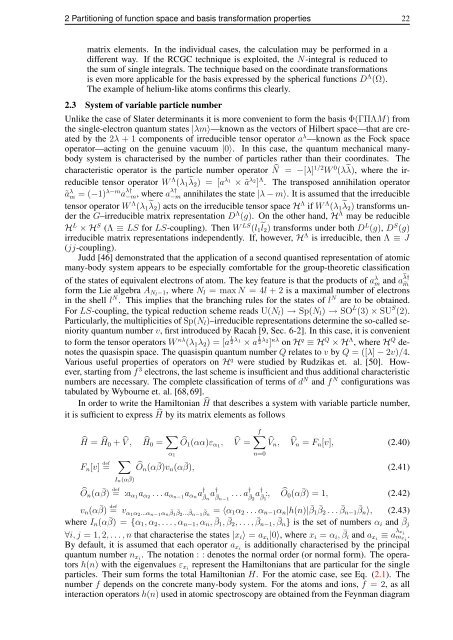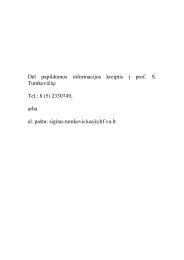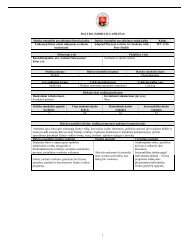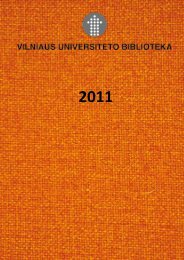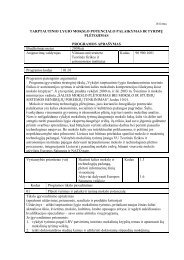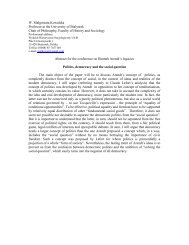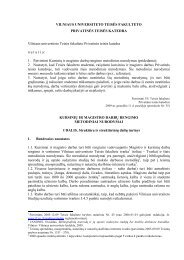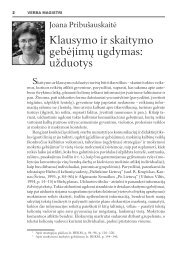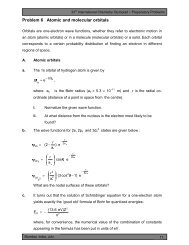Algebraic development of many-body perturbation theory in ...
Algebraic development of many-body perturbation theory in ...
Algebraic development of many-body perturbation theory in ...
- No tags were found...
Create successful ePaper yourself
Turn your PDF publications into a flip-book with our unique Google optimized e-Paper software.
2 Partition<strong>in</strong>g <strong>of</strong> function space and basis transformation properties 22matrix elements. In the <strong>in</strong>dividual cases, the calculation may be performed <strong>in</strong> adifferent way. If the RCGC technique is exploited, the N-<strong>in</strong>tegral is reduced tothe sum <strong>of</strong> s<strong>in</strong>gle <strong>in</strong>tegrals. The technique based on the coord<strong>in</strong>ate transformationsis even more applicable for the basis expressed by the spherical functions D Λ (Ω).The example <strong>of</strong> helium-like atoms confirms this clearly.2.3 System <strong>of</strong> variable particle numberUnlike the case <strong>of</strong> Slater determ<strong>in</strong>ants it is more convenient to form the basis Φ(ΓΠΛM) fromthe s<strong>in</strong>gle-electron quantum states |λm〉—known as the vectors <strong>of</strong> Hilbert space—that are createdby the 2λ + 1 components <strong>of</strong> irreducible tensor operator a λ —known as the Fock spaceoperator—act<strong>in</strong>g on the genu<strong>in</strong>e vacuum |0〉. In this case, the quantum mechanical <strong>many</strong><strong>body</strong>system is characterised by the number <strong>of</strong> particles rather than their coord<strong>in</strong>ates. Thecharacteristic operator is the particle number operator ̂N = −[λ] 1/2 W 0 (λ˜λ), where the irreducibletensor operator W Λ (λ 1˜λ2 ) = [a λ 1× ã λ 2] Λ . The transposed annihilation operatorã λ m = (−1) λ−m a λ†−m, where a λ†−m annihilates the state |λ − m〉. It is assumed that the irreducibletensor operator W Λ (λ 1˜λ2 ) acts on the irreducible tensor space H Λ if W Λ (λ 1˜λ2 ) transforms underthe G–irreducible matrix representation D Λ (g). On the other hand, H Λ may be reducibleH L × H S (Λ ≡ LS for LS-coupl<strong>in</strong>g). Then W LS (l 1˜l2 ) transforms under both D L (g), D S (g)irreducible matrix representations <strong>in</strong>dependently. If, however, H Λ is irreducible, then Λ ≡ J(jj-coupl<strong>in</strong>g).Judd [46] demonstrated that the application <strong>of</strong> a second quantised representation <strong>of</strong> atomic<strong>many</strong>-<strong>body</strong> system appears to be especially comfortable for the group-theoretic classification<strong>of</strong> the states <strong>of</strong> equivalent electrons <strong>of</strong> atom. The key feature is that the products <strong>of</strong> a λ λ†m and a e emform the Lie algebra A Nl −1, where N l = max N = 4l + 2 is a maximal number <strong>of</strong> electrons<strong>in</strong> the shell l N . This implies that the branch<strong>in</strong>g rules for the states <strong>of</strong> l N are to be obta<strong>in</strong>ed.For LS-coupl<strong>in</strong>g, the typical reduction scheme reads U(N l ) → Sp(N l ) → SO L (3) × SU S (2).Particularly, the multiplicities <strong>of</strong> Sp(N l )–irreducible representations determ<strong>in</strong>e the so-called seniorityquantum number v, first <strong>in</strong>troduced by Racah [9, Sec. 6-2]. In this case, it is convenientto form the tensor operators W κλ (λ 1 λ 2 ) = [a 1 2 λ 1× a 1 2 λ 2] κλ on H q ≡ H Q × H Λ , where H Q denotesthe quasisp<strong>in</strong> space. The quasisp<strong>in</strong> quantum number Q relates to v by Q = ([λ] − 2v)/4.Various useful properties <strong>of</strong> operators on H q were studied by Rudzikas et. al. [50]. However,start<strong>in</strong>g from f 3 electrons, the last scheme is <strong>in</strong>sufficient and thus additional characteristicnumbers are necessary. The complete classification <strong>of</strong> terms <strong>of</strong> d N and f N configurations wastabulated by Wybourne et. al. [68, 69].In order to write the Hamiltonian Ĥ that describes a system with variable particle number,it is sufficient to express Ĥ by its matrix elements as followsĤ = Ĥ0 + ̂V , Ĥ 0 = ∑ f∑Ô 1 (αα)ε α1 , ̂V = ̂V n , ̂Vn = F n [v], (2.40)α 1F n [v] def= ∑I n(α ¯β)n=0Ô n (α ¯β)v n (α ¯β), (2.41)defÔ n (α ¯β) = :a α1 a α2 . . . a αn−1 a αn a †¯βn a †¯βn−1 . . . a †¯β2 a †¯β1 :, Ô 0 (α ¯β) = 1, (2.42)defv n (α ¯β) = v α1 α 2 ...α n−1 α n ¯β1 ¯β2 ... ¯β n−1 ¯βn = 〈α 1 α 2 . . . α n−1 α n |h(n)| ¯β 1 ¯β2 . . . ¯β n−1 ¯βn 〉, (2.43)where I n (α ¯β) = {α 1 , α 2 , . . . , α n−1 , α n , ¯β 1 , ¯β 2 , . . . , ¯β n−1 , ¯β n } is the set <strong>of</strong> numbers α i and ¯β j∀i, j = 1, 2, . . . , n that characterise the states |x i 〉 = a xi |0〉, where x i = α i , ¯β i and a xi ≡ a λx im xi .By default, it is assumed that each operator a xi is additionally characterised by the pr<strong>in</strong>cipalquantum number n xi . The notation : : denotes the normal order (or normal form). The operatorsh(n) with the eigenvalues ε xi represent the Hamiltonians that are particular for the s<strong>in</strong>gleparticles. Their sum forms the total Hamiltonian H. For the atomic case, see Eq. (2.1). Thenumber f depends on the concrete <strong>many</strong>-<strong>body</strong> system. For the atoms and ions, f = 2, as all<strong>in</strong>teraction operators h(n) used <strong>in</strong> atomic spectroscopy are obta<strong>in</strong>ed from the Feynman diagram


